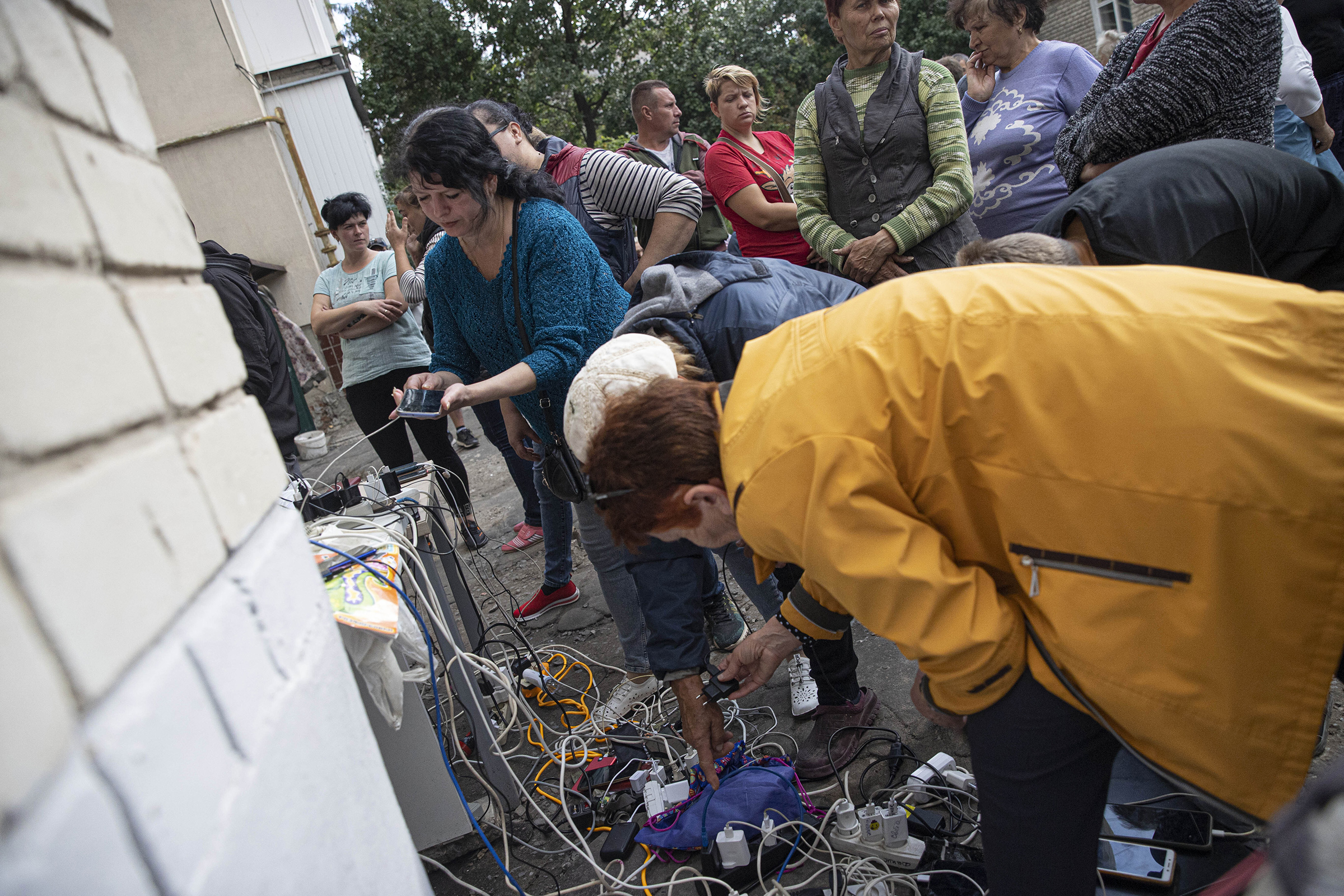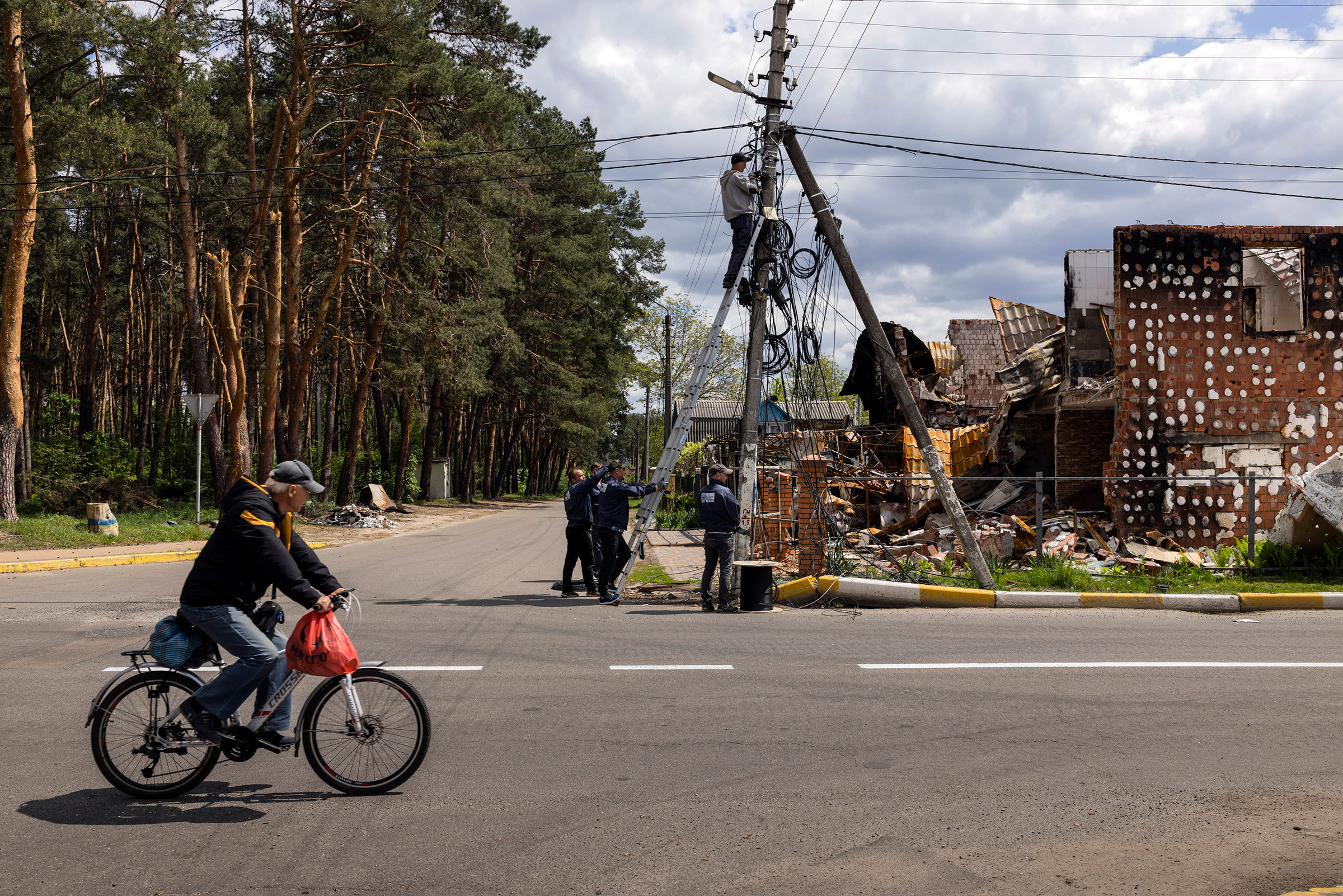In the wake of Ukraine’s surprise counter-offensive that reclaimed vast swathes of the country’s northeast from Russian forces, teams of local technicians and engineers have quietly arrived. Wearing bulletproof vests and helmets amid the ongoing shelling, often escorted by Ukrainian troops to avoid land mines, these workers barely wait to see the last of the retreating Russian soldiers before getting to work on repairing the damaged base stations and fiber-optic cables that have left hundreds of towns and villages cut off from news of their families and the outside world.
These dogged efforts to restore Internet and mobile connection underscore the urgency with which Ukrainian officials view the communications blackout in previously occupied areas. “The first thing that the Russians do when they occupy these territories is cut off the networks,” Stas Prybytko, the head of mobile broadband development in Ukraine’s Ministry of Digital Transformation, tells TIME. “Then the people living there don’t know what’s happening in Ukraine, they can’t call family to describe the situation, they don’t know whether their relatives are alive or not.”
The battle for control over Ukraine’s Internet shows how both sides view online access as a critical weapon in a 21st century war. The steady stream of videos and photos from Ukraine have been a critical component of the war effort, giving the world a front-row seat to the invasion. Russia’s moves to cut off access to Internet and mobile networks left Ukrainians living under occupation in an information vacuum which Russia filled with its own propaganda. Throughout the fighting, much of the evidence of atrocities committed by Russian troops in occupied areas has emerged long months after the crimes were committed.
Russia’s attempts to control the flow of information have been extensive. More than 4,000 base stations belonging to Ukrainian telecommunications providers have been seized or destroyed by Russian soldiers since the beginning of the invasion, and more than 60,000 kilometers of fiber-optic lines used for Internet have been captured or damaged, according to Ukraine’s Special Communications Service. Russian forces also destroyed 18 broadcasting antennas that provided television and radio signal. In some areas of southern Ukraine, Russia appears to have rerouted Internet traffic through their own providers, exposing it to the Kremlin’s vast system of surveillance and censorship.
Read More: Inside the Ukrainian Counterstrike That Turned the Tide of the War.
In the aftermath, telecommunications workers have emerged as “invisible heroes,” lauded by Ukrainian officials and social-media posts from residents showing them working in the midst of the destruction, wearing the familiar bright jackets and logos of Ukraine’s main providers. Despite ongoing outages and bombardment, most of the country has stayed online. Liberated territories have been restored at impressive speed, according to outside analysts. As of Oct. 13, Ukrainian mobile operators have rebuilt 71 of their base stations in towns and cities liberated from Russian occupation since the beginning of the counter-offensive last month, according to figures shared with TIME by Ukraine’s Digital Ministry. In total, Ukrainian telecommunications workers have restored 1,232 base stations in areas occupied by the Russians since March. Before repairs are even completed, officials have been setting up makeshift WiFi spots where locals stand in long lines to go online for 15 minutes apiece to avoid overwhelming the flimsy connection, according to photos posted on Telegram groups.
This work has often come at great risk to the lives of the technicians who work for Ukraine’s mobile and Internet providers. Earlier this month, a vehicle carrying four Ukrtelecom employees blew up after driving over a land mine in the Sumy region, injuring three people and killing the driver. In Russian airstrikes on Oct. 10, some of which targeted telecommunications buildings, four employees for Ukraine’s department overseeing digital infrastructure were killed in eastern Luhansk and Dnipro.
Ukrainian officials say the urgency of regaining control of Ukraine’s networks is clear to everyone involved in the effort. “These restorations are being made with some really heroic efforts from these guys,” says Prybytko. “It’s still very dangerous to do this work, but we can’t wait to do this, because there are a lot of citizens in liberated villages who urgently need to connect.”

After Russian troops invaded Ukraine in February, their occupation of Ukrainian towns followed a pattern. After establishing control, their first stop was often the offices of the local Internet service provider, Ukrainian officials tell TIME. There they often seized telecommunications networks at gunpoint.
To avoid handing the Russians control of local Internet and phone services, employees of these service providers sometimes destroyed equipment as soon as it became clear the area was coming under occupation. Some of these workers were imprisoned by Russian forces, including employees of Ukrtelecom, one of the country’s leading providers, according to the company.
“The Russians tried to connect their control boards and some equipment to our networks, but they were not able to reconfigure it because we completely destroyed the software,” Ukrtelecom CEO Yuriy Kurmaz said in July. “We will never collaborate.”
But many smaller providers were forced to operate under Russian control. Starting in April and May, digital watchdogs who spoke to TIME noticed that some providers in the southern region of Kherson were re-routing their customers’ Internet traffic through a Crimea-based affiliate of Rostelcom, a Russian state-owned company, exposing them to the Kremlin’s surveillance and censorship. By June, roughly 700 Ukrainian service providers were being controlled by Russian occupying forces, according to Liliia Malon, the commissioner of Ukraine’s digital infrastructure and services regulator.
Read More: The Man on Ukraine’s Digital Frontline.
It’s part of a familiar playbook, says Doug Madory, director of internet analysis for Kentik, a firm that monitors the performance of Internet networks. Russia did the same when it annexed Crimea in 2014, laying an underwater cable across the Kerch Strait that connected the peninsula with Russia and allowed it to bypass Ukrainian telecommunications companies.
The success of the Russian operation is measurable. Since the invasion began in late February, the number of users connecting to the Internet in Ukraine has shrunk by at least 16% nationwide, according to figures shared with TIME by London-based industry research group Top10VPN. The occupied regions of Kherson, Donetsk and Luhansk have seen a reduction in accessible IP addresses of 81%, 58%, and 56%, respectively, according to the group’s analysis, and there have been at least 276 Internet disruptions in Ukraine totaling 19,000 hours.
The damage may have been more significant were it not for Ukraine’s complicated telecommunications infrastructure, which relies on a web of hundreds of separate mobile and Internet providers, says digital-rights researcher Samuel Woodhams.
“The kind of decentralized nature of it was also a benefit, because it meant that the Russian forces couldn’t go into one office and take down a whole region,” says Woodhams. “There were hundreds of these offices and the actual hardware was quite geographically separated.” While this in part helped Ukraine’s resilience, “obviously that also means that you’ve got to do it quite piecemeal” to bring them back online one by one, he adds.

That massive task has largely fallen to Prybytko, the 33-year-old head of Ukraine’s mobile development department. When he spoke to TIME from Kyiv on Sept. 28, he was simultaneously dealing with engineers who had come under artillery fire trying to restore service in a recently reclaimed area and resistance from locals in another region who objected to the installation of a mobile tower on the roof of a hotel. The latter was due to festering conspiracies that they cause health problems, Prybytko says, which have been exacerbated by the trauma of wa.
“We still have this problem and we face it at least once a week,” he told TIME with a weary smile. “A lot of people still think that it could harm them.”
This was supposed to be a big year for Prybytko’s 11-person team in Ukraine’s Digital Ministry, which was planning to begin an ambitious effort to move towards 5G technology. Instead, they are spending their days trying to navigate a patchwork of basic fixes to restore any workable connection to parts of the country.
His team has been meeting with other government officials in a new working group set up to coordinate these efforts with local authorities and mobile providers. It has scrambled to make safety assessments, provide military escorts to areas until recently occupied by Russian troops, and find the necessary equipment in local warehouses.
The biggest challenge has been the physical safety of the repair teams. In addition to the threat of coming under bombardment, “the mining of base stations is a big problem,” Prybytko says, because the Russians have used land mines “to avoid faster restoration of service.”
Read More: How Ukraine is Crowdsourcing Digital Evidence of War Crimes.
In those cases, crews have to wait for Ukraine’s State Emergency Service to clear the area before they can access it. After assessing the damage and determining what equipment might be needed, they try to secure what they can from nearby warehouses. Many recently liberated areas are without power, requiring teams to run manual diesel generators to do their work.
While the war continues, Ukrainian officials and Internet providers say they’ve already won on the digital front. Rival carriers have worked together to provide roaming coverage for Ukrainian users, who are able to jump from one network to another one if their provider’s coverage goes down. They’ve also collaborated to repair each others’ bombed-out base stations. Since the start of the war, Ukrainian mobile operator lifecell has carried out more than 55,000 crew visits to repair equipment, the company told TIME, and 92% of its networks are now operational. Ukrtelecom has 87% of its regional offices back online.
“We really have brave technical teams and mobile operators,” says Prybytko. “Despite the danger to their lives, they will continue to go to cities and villages in war zones…because they know the importance of what many people treated as trivial before: make a phone call, browse the news. It’s not a situation someone could imagine in the 21st century.”
More Must-Reads from TIME
- Cybersecurity Experts Are Sounding the Alarm on DOGE
- Meet the 2025 Women of the Year
- The Harsh Truth About Disability Inclusion
- Why Do More Young Adults Have Cancer?
- Colman Domingo Leads With Radical Love
- How to Get Better at Doing Things Alone
- Michelle Zauner Stares Down the Darkness
Write to Vera Bergengruen at vera.bergengruen@time.com
